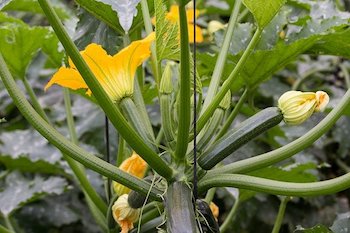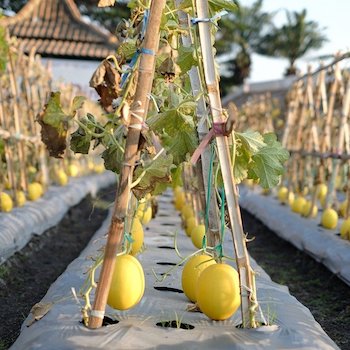
By Bethany Hayes
Don’t let your lack of a large garden space deter you from growing fresh vegetables. When you lack garden space, you still have plenty of vertical space. There are plenty of vegetables you can grow vertically in small areas; it’s a win-win idea!
Even gardeners with ample garden space turn to vertical gardening. Not only does it add a visual aspect and beauty to your garden, but it also helps increase air circulation and decrease pests and diseases. Healthy vegetable plants produce larger harvests, so you can expect quite a bounty from these plants.
Not all vegetables grow vertically, so we picked the best choices to add to your garden. Let’s take a look at the best vegetables you can grow vertically.
The Benefits of Growing Vegetables Vertically
Over the last few years, more gardeners have turned to vertical gardening, and for good reasons! There are several benefits to this method, such as:
Saves Space
When you don’t have a lot of space, vertical gardening makes sense because it saves space and allows you to be productive. Some plants that grow vertically take up a lot of ground space, such as cucumbers or squashes. Training plants to grow upwards rather than outward saves space while also producing the same number of fruits.
Decreases Pest and Disease Problems
When plants sprawl out over the ground, it leaves them open to a range of pests and diseases. Pests find it easier to discover and eat your plants, and many diseases are soil-borne and prefer situations with low air circulation.
Vertically growing crops reduce how many contacts your plants have with wet soil, reducing rot or other fungal diseases.
Better Fruit Appearance
It may not make a huge difference, but it makes them straighter when fruits can hang vertically due to gravity. Nothing is in the way that might cause them to curve or become misshapen. Many fruits end up longer.
Makes Harvesting Easier
Do you ever get sick of crouching down to harvest all of your green beans? I sure do! When the veggies are hanging down above you, it makes it a lot easier to harvest, and it reduces the chance of you missing hidden veggies under the leaves.
11 Vegetables You Can Grow Vertically in Small Spaces
Not all veggies can be grown vertically, so we put a list together of the best choices. You can expect these plants to produce well on strong support systems.

1. Peas
All three types of peas – snow peas, snap peas, and garden peas – grow well vertically. They don’t require any fancy kind of support system. It can be as simple as a twin trellis.
Pea plants have tiny, delicate tendrils that carry the vines upwards, gripping onto any support type. It doesn’t take much work from you, and pea plants are vigorous growers. My kids love to eat garden peas off the vine, but pea plants can cover an entire arch with long, delicate vines filled with blossoms and pods.
You should know that pea plants are a cool-season crop, so they should only be grown in the spring and fall times. In the summer, you can replace them with pole beans or any other vining crop.

2. Green Beans
Without a doubt, green beans, often called pole beans, are the most popular vegetable that you can grow vertically. Green beans, wax beans, and French filet beans grow vertically, climbing up any strong trellis that you can create. Some plants easily reach 8-10 feet high.
One of the bonuses of growing pole beans rather than bush beans is that pole beans produce all growing season. Bush beans, on the other hand, mature at one time then stop.

3. Cucumbers
Everyone knows that you can grow cucumbers vertically. Whether you like slicing or pickling cucumbers, you can find vining varieties that will climb the tallest fence or archway.
One of the greatest things about growing cucumbers vertically is that it makes it a lot easier to spot the ripe fruit. When the vines grow on the grounds, stretching out everywhere, it’s easy for the fruit to hide under a leaf until it’s too ripe to enjoy. That won’t happen when you grow cucumbers vertically.
Cucumbers are vulnerable to a range of pests and diseases, so keeping them off the ground helps ensure they don’t become sick or damaged. You might not know that you can prune cucumber plants down to a single stem or prune off all branches that aren’t growing in the direction you want.

4. Pumpkins
You can’t grow massive pumpkins vertically, but you can grow smaller varieties, such as baby pumpkins, on different support systems. You do need to make sure whatever vertical support you select is strong enough to handle the weight.

5. Tomatoes
Indeterminate, or vining tomatoes, can be trained to grow up a vertical structure. Unlike determinate or bush tomatoes, these types continue to grow from the tip of the plant, and they handle structures like cages or poles.

6. Winter Squash
Growing full-size winter squash vertically is possible, but if you decide to grow spaghetti squash vertically, you’ll need to provide a hammock to support the squash. If you don’t do so, the fruit’s weight will pull down hard on the vine, causing it to snap.
Not all fruits need a hammock for support. Some varieties, such as Winter Acorn or Honey Nut Butternut, are small enough that they wouldn’t break the vines.

7. Summer Squash
Summer squash plants, like zucchini, love to spread out and take up valuable space in your garden. They tend to spread over to neighboring plants and choke them out.
Many summer squash varieties are bush or semi-vining plants, which can be hard to train on a trellis. A few types produce more massive vines that can be grown vertically. Remember that these plants aren’t natural climbers, but they’re natural viners. You will need to weave the vines around whatever support system you use regularly. Twine can be used to secure the vines.
You’ll also want to use hammocks under the squash to prevent the fruits from breaking the vines. This can be a great way to enjoy your favorite summer squash still but avoid the vines taking over entire garden beds.

8. Watermelon & Cantaloupe
Most people don’t think about growing watermelon or cantaloupe vertically, but it’s possible if you select a smaller variety that only weighs a few pounds. You don’t want to try to grow a massive 15-pound watermelon on an arch or teepee. Not only would that weigh down your support system, but it would, more than likely, snap the vines.
Just like with squashes, you’ll need to create hammocks to support the growing fruits. Your goal is to keep the mature size of the varieties you select under 10lbs. The smaller, the better. Here are some excellent choices for melons if you want to grow vertically.
- Golden Midget Watermelon
- Golden Jenny Melon
- Charentais Melon
- Eden’s Gem Melon

9. Gourds
Do you like growing luffas or birdhouse gourds? These plants have long vines that make it challenging to grow them anyway but vertically. Otherwise, they end up taking over other garden beds in the area and suffocating other plants. Some luffa plant vines measure up to 30 FEET long – seriously!
Due to these vines’ length, do make sure you have an extensive enough support system to handle them. Arches tend to work well because you can make them taller, and the vines can go down the opposite side.

10. Nasturtiums
Technically, nasturtiums aren’t a vegetable, but they’re one of my favorite edible flowers. You can toss them into salads for a nice peppery bite, so I wanted to make sure to include them because they’re an edible ornamental plant.
Nasturtiums LOVE to climb, reaching up to 10 feet tall. They can cover garden fences and trellises with a burst of beautiful color in your garden. Nasturtiums come in a range of colors, such as red, yellow, and orange.

11. Hops
Most people don’t think about hops because it’s primarily used to create beer, but it’s still considered a vegetable. Believe it or not, you can use hops for more than just making beer, but beer is always valuable!
In the late spring, hop shoots develop on the plants, and those are edible and yummy. You might be hesitant to give them a try, but they’re worth it. You can’t find this in the store. The only way to enjoy hop shoots is either to forage them in the wild or plant hops and grow it in your garden.
You can eat hop shoots raw, in salads, or sauteed in butter or bacon grease. Some say that they taste just like asparagus but even more delicious.
These plants can be huge – around 15 feet long. Don’t be surprised if it vines over the top of your trellis or fence.
Try Growing Vertically This Year
If you don’t have a large garden space, think about trying some vegetables you can grow vertically in small areas. With the right plants and support systems, you can have a harvest equal to traditional garden beds without using as much space. Plants can be quite vigorous and prolific when grown vertically, so give it a try yourself!
Learn More About Growing Vegetables Vertically
https://pss.uvm.edu/ppp/articles/vertgard.html
https://content.ces.ncsu.edu/home-vegetable-gardening-a-quick-reference-guide

Love the information on vertical gardening